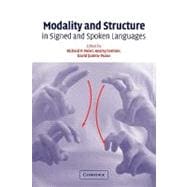
Note: Supplemental materials are not guaranteed with Rental or Used book purchases.
Purchase Benefits
What is included with this book?
| Why different, why the same? Explaining effects and non-effects of modality upon linguistic structure in sign and speech | |
| Phonological Structure in Signed Languages | |
| Modality differences in sign language phonology and morphophonemics | |
| Beads on a string? Representations of repetition in spoken and signed languages | |
| Psycholinguistic investigations of phonological structure in American Sign Language | |
| Modality-dependent aspects of sign language production: evidence from slips of the hands and their repairs in German Sign Language | |
| The role of manually coded English in language development of deaf children | |
| Gesture and Iconicity in Sign and Speech | |
| A modality-free notion of gesture and how it can help us with the morpheme vs. gesture question in sign language linguistics (or at least give us some criteria to work with) | |
| Gesture as the substrate in the process of ASL grammaticization | |
| A cross-linguistic examination of the lexicons of four signed languages | |
| Syntax in Sign: Few or No Effects of Modality | |
| Where are all the modality effects? | |
| Applying morphosyntactic and phonological readjustment rules in natural language negation | |
| Nominal expressions in Hong Kong Sign Language: does modality make a difference? | |
| Using Space and Describing Space | |
| Pronominal reference in signed and spoken language: are grammatical categories modality-dependent? | |
| Is verb agreement the same cross-modally? | |
| The effects of modality on spatial language: how signers and speakers talk about space | |
| The effects of modality on BSL development in an exceptional learner | |
| Deictic points in the visual/gestural and tactile/gestural modalities | |
| Table of Contents provided by Publisher. All Rights Reserved. |
The New copy of this book will include any supplemental materials advertised. Please check the title of the book to determine if it should include any access cards, study guides, lab manuals, CDs, etc.
The Used, Rental and eBook copies of this book are not guaranteed to include any supplemental materials. Typically, only the book itself is included. This is true even if the title states it includes any access cards, study guides, lab manuals, CDs, etc.